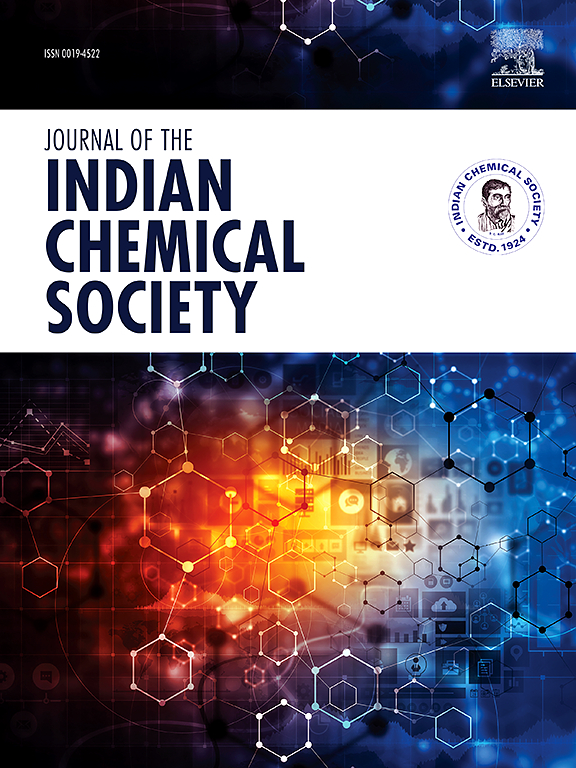用于超级电容器的生物质衍生活性炭的电化学性能和稳定性增强
IF 3.2
4区 化学
Q2 CHEMISTRY, MULTIDISCIPLINARY
引用次数: 0
摘要
本研究探讨了利用KOH和NaOH两种活化剂(CPF- ac (KOH)和CPF- ac (NaOH))合成由Calotropis procera fruit (CPF)衍生的多孔活性炭(ACs),以生产低成本、先进的高性能超级电容器电极材料。结果表明,CPF-AC(KOH)和CPF-AC(NaOH)形成了最佳的多孔结构,并结合了微孔和介孔。NaOH活化比KOH活化更有利于中孔的形成。CPF-AC(KOH)表现出最佳的比表面积(2953.13 m2 g−1),石墨化程度高于CPF-AC(NaOH)。在三电极体系中,CPF-AC(KOH)和CPF-AC(NaOH)在电流密度为1 a g−1时的重量比电容分别为341和286 F g−1。CPF-AC(KOH)在0.1 A g−1时的峰值重量比电容为438 F g−1,在10 A g−1时保持288 F g−1。在双电极下,CPF-AC(KOH)在2489 W kg−1的比功率下显示出41.1 Wh kg−1的高比能。CPF-AC(KOH)具有高效的充放电性能、低内阻和强大的循环稳定性,在5 A g−1下进行10000次循环后仍能保持82%的电容,这突出了CPF-AC(KOH)作为先进超级电容器应用和先进储能技术的可持续和环保的候选材料。本文章由计算机程序翻译,如有差异,请以英文原文为准。

Enhanced electrochemical performance and stability of biomass-derived activated carbon for supercapacitor applications
This study explores the synthesis of porous activated carbons (ACs) derived from the Calotropis procera fruit (CPF) using two activators, KOH and NaOH (CPF-AC(KOH) and CPF-AC(NaOH)), to produce low-cost and advanced electrode materials for high-performance supercapacitors. The findings indicate that CPF-AC(KOH) and CPF-AC(NaOH) form the best porous structures and combine micropores and mesopores. The Activation with NaOH favors mesopore formation more strongly than Activation with KOH. The CPF-AC(KOH) exhibits the best specific surface area (2953.13 m2 g−1) with higher graphitization than that of CPF-AC(NaOH). In a three-electrode system, CPF-AC (KOH) and CPF-AC(NaOH) demonstrate gravimetric-specific-capacitances of 341 and 286 F g−1 at a current density of 1 A g−1. CPF-AC(KOH) at 0.1 A g−1 reaches a peak gravimetric-specific-capacitance of 438 F g−1, retaining 288 F g−1 at 10 A g−1. In a two-electrode, the CPF-AC(KOH) demonstrates a high specific-energy of 41.1 Wh kg−1 at a specific-power of 2489 W kg−1. The efficient charge/discharge properties, low internal resistance, and powerful cycle stability, retaining 82 % of its capacitance after 10000 cycles at 5 A g−1, highlight CPF-AC(KOH) as a sustainable and environmentally friendly candidate for advanced supercapacitor applications and part of advancing energy-storage technologies.
求助全文
通过发布文献求助,成功后即可免费获取论文全文。
去求助
来源期刊
CiteScore
3.50
自引率
7.70%
发文量
492
审稿时长
3-8 weeks
期刊介绍:
The Journal of the Indian Chemical Society publishes original, fundamental, theorical, experimental research work of highest quality in all areas of chemistry, biochemistry, medicinal chemistry, electrochemistry, agrochemistry, chemical engineering and technology, food chemistry, environmental chemistry, etc.

 求助内容:
求助内容: 应助结果提醒方式:
应助结果提醒方式:


